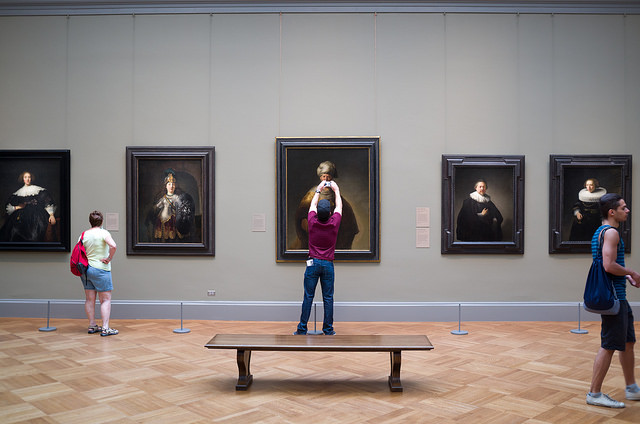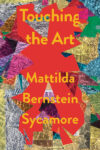In order to fight against extreme nationalism, racism, sexism, colonialism and other iterations of fascism, Virginia Woolf writes that we must uphold “freedom from unreal loyalties.” Polemical for her time, Woolf proffers the entirely detrimental effect of committing to and entrenching oneself fervently in a “pride of nationality… religious pride, college pride, family pride, sex pride” and the “unreal loyalties that spring from them.” All of us commit ourselves to causes, belief systems, people and places. Within the political context, we undertake loyalty oaths in order to establish irrefutable dedications to particular organizations and institutions. We commit ourselves to political leaders, we are often patriotic to our country, we are loyal to partners and we are diligent to animals. To pour our loyal libations into something, or many things, is undeniably human.
By playing the card of loyalty, we also willingly open ourselves up to loyalty’s bad sister, betrayal. Loyalty and betrayal, the cornerstones of Greek Tragedy, the benchmark of any soap opera; those binding moments where you are asked to abide or indeed forced to betray your oath, falling on one side of the fence or the other. Yet the ephemerality and intangibility of the loyal act prevails — James Connor calls this loyalty’s “invisible pull of a particular connection”. Woolf captures the invisible, illusory and imaginative nature of loyalty in the above statement: loyalties are “unreal”. That is, we conjure loyalty, commit to it and repeatedly act it out, over and over again, perhaps until we finally believe our loyalties, perhaps until we believe them so much that we would kill for them, destroy countries and worlds for them. The oath is invisible, but its effects are undeniably real.
There are ostensibly objects of loyalty, or objects that remind us to be loyal. We live in a world of “reward points”, where we are cooed softly into positions of faithfulness. In my purse, I have a series of dog-eared loyalty cards: loyalty cards from cafés in Belgium, one from Estonia and several from cafés in London, which I no longer recollect having visited in the first place. We all own similar documents; the same dog-eared, tattered pieces of paper sealed with an imprint that shows we once had a cappuccino at La Belle Vita Coffee Shop some time in 2011. But it is the sheer volume of these cards that proves a sense of disloyalty to the objects themselves. The cards don’t decide where we purchase our daily coffee; we do, and the process by which we choose is complexly tied up with routine and ritual, superstition and convenience. Loyalty to place is an unspoken contractual agreement to return, to continue conjuring our commitment through repetition. The reward for place-loyalty is greater and more inscrutable than a free coffee at the end of an arbitrary predetermined cycle, though the latter may definitely help shore up the former.
What does loyalty to place look like? Outside of cafes and supermarkets, people gravitate to the same places every day; they visit the same bench that commemorates a family member, or they choose one particular pub over another, as they have been doing for fifteen years. Loyalty to place, however, is not just a matter of dependable frequency but of acting out certain repeatable behaviors in the space itself. We agree to continue performing the expectations of this unspoken loyal relationship: we comport ourselves the same each time in order to establish and honor the boundaries of our relationship with place. Loyalty to place is maintaining, supporting and bearing up these codes and conventions, some of which are inherited behavioral norms and some of which come from within. Place loyalty is a specifically coded (often invisible) way of agreeing to behave, which comes into being through co-present networks of other humans, places and events.
One arena where a loyalty to place is common is in the context of heritage, where tours of particular historical sites are often used to increase customer brand loyalty. Take, for instance, tours of British distilleries, which provide an opportunity to experience cultural heritage with an ulterior aim to ensure brand loyalty to a particular whiskey: see how it is made and continue to stimulate consumer interest and capital. Similarly, governments often use “heritage places, historic buildings and monuments to build patriotism and ensure their citizenry’s loyalty.” In the context of the museum, this loyalty is often deployed through careful marketing strategies, where products and services are made and sold to “create value and build solid customer relations and customer loyalty.” One such way to build place-loyalty is to ensure regular footfall from steady customers, especially by making them feel like a group of insiders.
I used to work as a Membership Assistant at a London gallery, where part of my role was to dutifully persuade members of the general public to join the gallery as a member. The customer then paid a certain amount per year to have a membership card and to be able to visit the gallery as much as they desired. They paid a sum, and they were able to be exercise and conjure their loyalty. They could visit whenever they wished, and there was a café specifically for this hallowed substratum of museum society. It is important for Visitor Services and for the museum in general that such loyalty/membership schemes exist.
Such loyalty schemes ensure a certain capital for the museum or heritage site. Yet when one enters into the museum, there are other, alternative modes of place-loyalty at play. There are codes of loyalty that exist in the space of the museum; codes that dictate particular modes of “loyal” behavior in relation to display methods, which stretch out from under the official auspices of membership cards and marketable loyalty schemes.
Entering Museum Leuven in Belgium, the visitor encounters a large sign. The sign is typical of one that we often find in a museum: a sign that prohibits certain types of behavior. Looking at it, I made a joke to my friend that the museum wanted to guarantee that we had no fun while visiting. Touching the artworks was prohibited with a black and white graphic depicting a hand touching an artwork with a large red cross through it. Similarly, smoking was prohibited, drinking and eating were prohibited and so was flash photography. These are commonplace stipulations in our heritage-based, museum-going, culture-consuming system: we know not to smoke next to a Picasso and we know not to joyfully gobble down a Twister next to a Brancusi.
Obeying these rules demonstrates our loyalty; to break them would be a betrayal. By not touching the artworks, by not eating ice cream and by not lighting up a cigarette, we are loyal to a place where certain modes of behavior are asked of us in order to prevent potential damage. Upholding the regulations stipulated by the sign, the visitor enters into a silent pact where we agree to maintain and preserve important public care policies: we don’t take flash photographs because we are loyal to the preservation of the artwork and don’t want to degrade the quality of the painting in front of us. We don’t run because we don’t want to trip and accidentally crash across the gallery floor to derail an unsuspecting Rothko. We obey the code of a place in order to allow it to continue on as such a place.
Recently, selfie sticks have been banned within museums (most notably at the National Gallery in London, UK, The Metropolitan Museum of Art, US, as well as the Smithsonian Museum Group, US). The sticks have also been prohibited at a number of theme parks in the US, Hong Kong and Paris, as well as several UK football grounds. In the context of the museum, they are considered potentially treacherous and understandably so — wielding a long stick around expensive and often fragile artworks and artifacts can have cataclysmic consequences. Selfie sticks in this sense then are a threat to the care policies of the museum, like flash photography, eating, running and smoking. But it wasn’t so long ago that photography in general, with or without flash, was banned altogether in most museums, typically due to copyright restrictions. Whatever the reasons, the ban on photography became a part of the culture of museum going, and abiding it, a sign of loyalty.
Now many members of the museum-going population carry camera phones, on which flash can be easily disabled. Instead of attempting to stem the tide of in-museum photography, several institutions have gotten on board. Tate now allows photography, without flash, in their collection, yet photography in temporary exhibitions is still completely prohibited. The National Gallery has only allowed photography without flash for the last year. Loyal museum-goers and critics are generally outraged when a museum allows for behavior previously deemed inappropriate. In reading the criticism of the recent introduction of photography in museums like the National Gallery, it would seem that many believe photography to be unfaithful to the “invisible” commitment the loyal undertake when entering the museum. Photography, with or without flash, would seem to show place-disloyalty, a kind of oath-breaking.
Unlike restrictions on selfie-sticks and flash photography, bans on general photography in museums have no logistical basis once the copyright question is resolved (which one can assume it is when a museum decides to allow photographs). The impetus for criticizing the lifting of photography bans, then, is not rooted in logistical notions of preservation and conservation protocol. Instead, the problem of photography concerns the more invisible forms of loyalty and disloyalty, care and lack of care toward the museum.
In an article for The Telegraph, Rupert Christiansen wrote that museums “are designed for calm contemplation, thought, study and reverence, places where bustle stops and hush prevails.” For Christiansen, pushing past other visitors to take photographs of famous artworks is the antithesis of the museum’s purpose: a place which historically and etymologically was a space for quiet, solitary reflection on art objects. Moreover, Brian Sewell argues that photography functions to “ruin the proper museum experience,” and one keen museum blogger writes “instead of reflecting and appreciating brush strokes, technique, perspective, lighting, and all that other stuff that gets art majors laid when they talk about it, you’re staring at a 2”x 2” display screen on the back of a camera. You might end up with a picture of the Mona Lisa, but you won’t remember having seen it for yourself.”
Old-guard museum loyalists, whose personal identities may be wrapped up in demonstrating faithful commitment to the museum space, are evidently quite concerned with the sanctity of heretofore agreed-upon proper museum decorum, where we are supposed to reflect and contemplate in hushed voices. Jasper Joffe, who scolds the museum-going masses for walking around too often with an “anaesthetised indifference to the objects on display,” argues that taking photographs simply adds to this problem. Arguably “indifference”, a term that suggests apathy or lack of commitment or care, is the opposite of loyalty; like smoking a cigarette or devouring a sandwich, indifference betrays the cultural codes of the museum as a place. For Joffe, it is as though taking a photograph violates an unspoken oath, signed as we entered through the museum doors, to walk in silence and contemplate; photography somehow undermines the “essence” of this place.
Often art galleries and museums, particularly large ones, are famous tourist spots, where certain works become must-see destinations. These museum tourist spots are, more often than not, known through photographs or images of the artwork. One such example is the Mona Lisa at Le Louvre; we have perhaps come to know the photograph of the Mona Lisa more so than the work itself. David Bates writes that “tourism, for example, depends on photographic views to sell holiday destinations in its brochure images; views which are often bought as postcards.” Crowd-gatherers like the Mona Lisa function in a similar way. Famous artworks, installations and art pieces often depend of the photographic views of these works that circulate on museum websites, Facebook, Instagram, and Google to sell these museums as destinations to visit in the first place. Indeed, the museum consistently tiptoes between the difficulty of exposing the museum’s collection to a large number and variety of people and ensuring the very collection it is trying to promote is protected and preserved.
However, when attending Le Louvre to visit the Mona Lisa, there has often been criticism that people are no longer looking at the work itself, but instead view the work through the screen of the digital camera. In such arguments, the general premise is that through photographing the work, we are not providing the quality of attention that the work deserves. Instead we are viewing the work “camera-first”. As inferred by the writer above, how can we “truly” experience a work if it we view it through a screen? Thus, not only have we been led initially to the work by seeing photographs of the work, we are now looking at the work in person through the lens of a camera. Indeed according to Joffe, this type of photography-led viewing is apparently not the sort of “looking” we want in the consecrated place of the museum.
However, the supposedly stultifying effect of photography, in the form of inattentive and mediated viewing, is a critical debate that writers on photography have been grappling with for over a century and one that has faced much criticism by writers ranging from Walter Benjamin to Vilém Flusser. And indeed, what becomes clear in the words of the critics and journalists above is that reeling a camera around a museum or gallery is tantamount to becoming a 21st century drone, programmed to take apathetic photographs of objects we haven’t even endeavored to contemplate or experience in the first place. The attitude of this act is postured through inattention, distraction and lack of care or concentration. Indeed, in light of the comments by the above critics, it would seem that taking a photo at a museum mediates what could be the “pure” experience of “being there” in the museum.
Susan Sontag opines that taking a photograph is a “way of certifying experience”, yet it can also be a way of “refusing it — by limiting experience to a search for the photogenic, by converting experience into an image, a souvenir.” Arguably, one might agree that in the case of photography’s (re)introduction into the museum, visitors are limiting their experience by taking a photograph as a token, in lieu of trying to truly understand, contemplate and experience the work in front of them. Sontag also argues that taking a photograph is an act characterized by the search for the photogenic — as if we are sniffing out the photo opportunity at the museum. In the case of certain art installations premiering of late, this is perhaps particularly pertinent. For example, Martin Creed’s retrospective, What’s the point of it, at the Hayward Gallery in London in 2014 attracted a high volume of visitors. One journalist wrote in her review of the exhibition, “most importantly bring your camera/phone to capture moments of merriment for posterity like these folks below” and then displays around 10 pictures of visitors careering around the installation. Here the reviewer promotes Sontag’s anxiety over the search for the photogenic; bring your DSLR or iPhone, snap some photos, remember the experience forever.
Although this search for the photogenic is interpretable as an indifferent search for imagistic souvenirs, Sontag also debates that by taking the photograph, we are indeed actively interpreting the world. In her introduction to On Photography, Sontag writes, “although there is a sense in which the camera does indeed capture reality, not just interpret it, photographs are as much an interpretation of the world as paintings and drawings are.” In this statement, the act of taking a picture mediates the thing that we see in front of us; it interprets the world and has the potential to change it. Sontag’s active interpretation argument deviates from the perspective that photography engenders only stilted and inattentive image capturing.
Arguably taking a photograph of an artwork promotes one’s own sense of pseudo-ownership over the object. This may surface in the form of adding a filter or taking a photograph from a certain angle. As such, by taking a photograph, the art object no longer exists autonomously out-of-time. The visitor confuses the artwork’s objecthood by generating meaning and actively interpreting the work outside of the work’s frame by pulling it, quite literally, into their own frame. It has been subsumed suddenly into the eye, and fixed within the camera lens, of the beholder. We might argue then that one of the major anti-photography-in-museum debates is centered upon the viewer thinking that they themselves are the artist.
Many critics deplore the notion that Twitter, Instagram and other platforms that allow visitors to add filters to their photographs offer visitors a sense of artistic agency. Through Instagram, we are able to truly fulfill Joseph Beuys’s contestation that “everyone” is an artist. Indeed, taking a photograph allows each museum-goer to edit and manipulate the artworks they see, playing fast and loose with the near instantaneous relation between seeing an artwork and producing one. Critics would seem to dislike the agency that such photographic mediums offer. If we are taking an image, uploading it onto various social media sites and showing our relatives, how are we meant to quietly and meditatively contemplate Bathers at Asnières? Moreover, what if we no longer even needed to visit the museum to view the work when all the images exist on the Internet?
The anxiety over photography in museums is also centered upon the fear that if we continue to take photo after photo, will we begin to see the images as the “thing”, as opposed to the “thing” itself. However, Sontag importantly argued that “in the situations in which most people use photographs, their value as information, is of the same order as fiction.” I would suggest that instead of becoming anxious about photography’s threat to overtake the status of the work itself, we should instead trust that the act of a taking a photograph is one fictionalized and interpretative way of seeing among many.
Katherin Yacavone argues that “in relation to the photographic other, both [Walter] Benjamin and [Roland] Barthes draw attention to the beholder’s active role in establishing a truth beyond the mere appearance of a person before the camera in some emphatically past moment in time: namely a recognition of both his or her true nature, or some aspect of it, and the presence and value of that person for the beholder in the perpetual now of the photograph’s concrete apprehension.” Yacavone promotes several tenets here that are important to bear in mind when considering photography in the museum. 1) The viewer has an active role in a establishing their perception of the photograph. And when we take into consideration Sontag’s argument here, this perception doesn’t need to be an expression of “truth”, it can be a fictionalized truth. 2) We can establish a truth beyond a photograph of the Mona Lisa. We trust that it may not look exactly the same as the photograph that my second cousin twice removed recently uploaded onto Instagram. 3) The thing in the photograph has presence in the now and this will impact each beholder in the perpetual now in a multitude of ways.
Museum loyalists have come to associate photography of artworks with inattention and disrespect. But what if taking a photograph is the very opposite of indifference or inattention? Is it not an act that allows for a multiplicity of interpretations both in the taking of the photograph and in its reception? Furthermore, what is a pure or unmediated experience of a museum and how have we come to associate the opposite with photography? Moreover, surely a prescribed and definitive method of viewing art is more devastating to the place of the museum than looking at a work of art through the lens of a camera. By dictating and following rigid terms for visual engagement, are we not being disloyal to other, equally important and qualitative modes of visuality within the place of the museum? Hasn’t the museum always been a place of shifting visualities and qualities of visual attention?
In this photograph by visual artist Thomas Struth, a flock of visitors mingle in the shared space of the museum. One boy stands to the right hand side sketching, and his fellow classmates also stand about sketching the work in front of them. One man walks against the tide, away from the painting, into the crowd of visitors. A woman in the foreground holds up her camera to take a photograph. The general public stands around, some look, some turn their backs, and other visitors read interpretation plaques, while still others chat amongst themselves. And in this moment, all while Struth watches them looking and not-looking, he captures an image with its own ecosystem of visual engagements. Struth’s photograph is a scene of unfolding visuality, one that demonstrates the multiplicity of visual methods within the museum. His photograph decentres the popular argument that there is only one legitimate mode of engaging with art in a museum.
A huge variety of museums now actually promote the use of photography. In the UK, the hashtag ‘MuseumSelfie’ trends on a daily basis, and museums encourage its use to promote engagement with their collections. Last year at the Jeff Koons retrospective at The Whitney Museum of American Art, visitor assistants passed out cards reading, ‘Koons Is Great for Selfies!’ One visitor may have picked this up and followed through with the suggestion by taking a picture in front of Balloon Dog (Orange), the flash reflected in the shiny, stainless steel surface. Another visitor may have picked the card up and decided instead to ignore the suggestion, or to take a photograph of the work instead, removing their face from the frame. Either way, each mode of engagement is a mode of seeing and equally legitimate as the next.
Photography is only disloyal to the museum if we accept that there is only one set of rules that we all must abide by in order to engage with the museum as a place. The museum has always been a space where the way we look has shifted, and where the locus of looking has been multiple. Taking photographs is one iteration or phenomenon on a vast spectrum of looking. Indeed, Jonathan Crary might call this mode of looking an “ongoing mutation in the nature of visuality.” That is, allegiances change and ways of looking which have perhaps always lain latent — or which had never before been possible — arise, constantly in flux.
The notion that photography is a betrayal is itself unfaithful to the possibilities of the museum. As Struth’s photograph illustrates, the museum has always been a melting pot of looks. Furthermore, what Woolf promotes in the first place is the avoidance of a fervent commitment to one particular mode of loyalty. Not taking photographs is an “unreal loyalty” to a projected sense of the museum as a place. In fact, when loyalties shift, mutate and change with the tide, new loyalties arise and we often find new ways to see.
Bryony White is a writer based in London, UK. She has a Masters in Performance Studies from King’s College London. She has written for The Learned Pig and Apollo Magazine, and runs the online magazine FeltActs.com. Bryony also currently teaches at a secondary school in South London.
This post may contain affiliate links.









